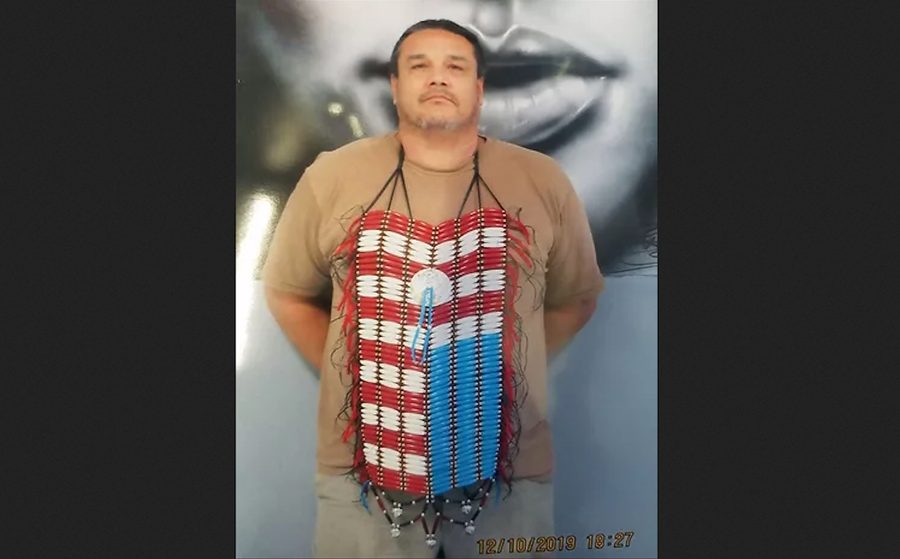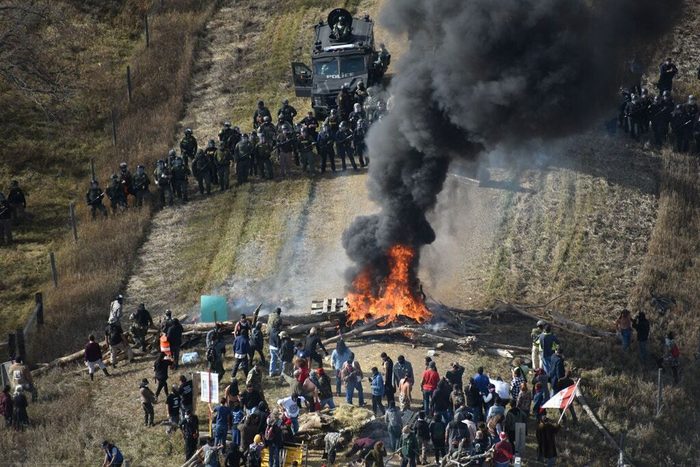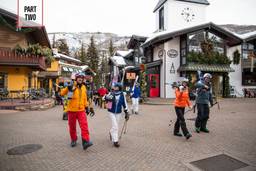‘People Are Still Putting Their Bodies on the Line to Stop this Pipeline’
A court found that the Dakota Access Pipeline was built unlawfully. These water protectors are still in prison for trying to stop it.
Joseph Bullington

Michael Markus, known as Rattler, had mixed emotions when he heard the news. A federal judge had ruled that the Dakota Access Pipeline was built unlawfully and ordered the pipeline to stop pumping oil pending an in-depth environmental review.
“We have, and are, going through a lot, but this would heal,” Markus wrote to Rural America In These Times. At the same time, he wrote, “it’s hard not to be heartbroken.” Markus sent the message from Sandstone federal prison in Minnesota, where he is serving a three-year sentence for trying to stop the pipeline from being built in the first place.
Markus, who is Oglalla Lakota, grew up on the Pine Ridge Reservation. He served in the U.S. Marine Corps and saw combat. In 2016, when the NoDAPL movement gained momentum and resistance camps formed near the Standing Rock Reservation, he made supply runs to the camps. When pipeline security guards unleashed attack dogs against water protectors in early September of that year, Markus moved into the camps to stay.
“Well I have been around a few years… lol, and I have been on a search to where I belong and what I need to be doing,” Markus wrote. “When I first went to camp I knew that I have found where I need to be and what I need to be doing.” He took on the traditional Lakota role of akicita, which in camp meant keeping the peace between water protectors and on the front lines meant watching “for infiltrators and instigators to protect people from getting hurt.”
In February 2017, as the pipeline neared completion and police prepared to clear the main Oceti Sakowin camp, Markus was one of a handful of people, all Native, hit with federal felony charges for crimes allegedly committed more than three months earlier. Markus was charged with Civil Disorder and Use of Fire to Commit a Federal Felony Offense, a charge that carries a mandatory minimum 10-year prison sentence. In 2018, he accepted a non-cooperating plea agreement in part because, as he wrote in to RAITT, “we were told we would not get a fair trial right from the get go.” In exchange for a guilty plea to the Civil Disorder charge, the prosecution agreed to drop the Use of Fire charge and recommend a 36-month sentence.
This experience left Markus skeptical the court system can deliver justice. “I don’t think it will be stopped [immediately],” he wrote in his mid-July message of the pipeline and the court order to shut it down. “Because these people have so much money that they can pay the pocket change fines and keep making millions.”
His words turned out to be prescient: Energy Transfer LP, the company behind the pipeline, challenged the ruling and on Aug. 5 a federal appeals court paused the shutdown order. The pipeline will continue to operate while the environmental review is conducted, pumping half a million barrels of oil per day out of North Dakota’s Bakken formation and under Lake Oahe on the Missouri River, just upstream from the Standing Rock Lakota (Sioux) reservation.

Meanwhile, Markus remains in prison — an increasingly dangerous place to be as the pandemic rages on. Covid-19 outbreaks have already swept through many prisons and detention centers and a recent report revealed that U.S. Marshalls are shipping Covid-positive inmates all over the federal Bureau of Prisons (BOP) system. As of this writing, Sandstone prison had three confirmed cases.
According to Olive Bias, a member of the NoDAPL Political Prisoner Support Committee, Markus has filed a request for release to home confinement, as provided for in the CARES Act in response to Covid-19, but has so far been denied release. A group called Loved Ones of Indigenous Federal Prisoners, which grew out of an effort by the Bismarck-Mandan Unitarian Universalist Church to support incarcerated water protectors, has petitioned for the immediate release of all federal prisoners with less than one year remaining in their sentences regardless of their offense, among other demands.
Bias, who uses they pronouns, says the BOP’s response to Covid-19 has “pretty much been to be punitive.” When the pandemic hit, Bias says, the BOP started putting prisons on lockdown. They read me Markus’s account of what that means on the inside: “Prisoners cannot leave their bunks. Guards designate shower time and potentially even bathroom breaks. No ceremony, no rec time … no TV room, no exercise.” Bias also read me a later report from Markus: “While being on lockdown we have no social distancing…. There are 62 men sharing three toilets, one urinal, three showers and five sinks…. We are a tinder box waiting for a spark and the guards are the spark.”
Bias works on Markus’s case as a paralegal but, like him, has little faith in the courts — in either their ability to keep prisoners safe from Covid-19 or to stop the pipeline.
“He’s going to stay in lock up for a pipeline we’ve been saying for over four years is illegal,” Bias says. “It’s a prime example of how deadly bureaucracy can be.”
When they first heard that the court had ruled the pipeline’s construction unlawful, Bias says, “I was happy, but it was like ‘What else is new?’ This is some more paper-pushing stuff.”
To Bias, “paper-pushing” was never going to be enough to stop the pipeline. “That’s why we went out and put our bodies on the line,” Bias says. “We didn’t need the courts to tell us that what we were doing was right.”
Bias grew up in Chemical Valley, West Virginia, where they learned that there is no guarantee of clean rivers or safe drinking water — a truth to which many of us in the West are dangerously naive. In 2014, as Evan Osnos recounts in his New Yorker article “Chemical Valley,” a storage tank spilled industrial coal mining chemicals into the Elk River upstream from the largest water-treatment plant in the state, poisoning the drinking water of some 300,000 people. That one plant served 16% of West Virginia’s population, Osnos writes, in part “because coal mining has reduced the availability and quality of other water sources, prompting West Virginians to board up their wells and tap into the public system.”
These lessons brought Bias, in 2016, to North Dakota to join the Lakota-led water protectors fighting DAPL.
“It’s what I do with my life because I had to grow up with family members who were sick because of extractive industry,” Bias says.
Bias lived in the anti-pipeline camps for five months and got seven state misdemeanor charges of their own. Bias has been dealing with the general legal aftermath of Standing Rock ever since, fighting their own charges and supporting the federal felony defendants.
As people celebrate the court ruling against the pipeline, Bias wants to remind them that the physical part of the struggle is not over.
“We’re still fighting this pipeline, because we still have people incarcerated for the work we did in camp,” Bias says. “People have got to recognize that people are still putting their bodies on the line in prison to stop this pipeline.”

All the federal felony charges stem from Oct. 27, 2016.
In late October, as pipeline construction approached the Missouri River from the west, many pipeline opponents moved a mile north from the main Oceti Sakowin and Sacred Stone camps and set up a frontline camp, where they erected teepees and tents directly in the pipeline’s path.
On “myth vs. fact” webpages, the pipeline company and state police assert that the pipeline does not cross tribal land. This is a deceitful oversimplification. The frontline camp was sited on land that the pipeline company had purchased in September 2016. As the water protectors pointed out, however, the land had been reserved for the Lakota under the 1851 and 1868 Fort Laramie treaties.
In the 1860s, Markus’s ancestor, the Oglala chief Red Cloud, led the Lakota in a war to stop white miners and settlers from moving through their land as reserved by the 1851 treaty. In 1868 the U.S. government capitulated and agreed to remove the forts along the Bozeman Trail. Only then did Red Cloud ride into Fort Laramie and sign the 1868 treaty, which closed the trail to white settlers and established the Great Sioux Reservation, a vast tract of land that comprised the entire western half of present-day South Dakota. The treaty also defined a massive “unceded Indian Territory,” which “no white person … shall be permitted to settle upon” or “without the consent of the Indians … to pass through….” The unceded territory contained large swaths of present-day Nebraska, Wyoming, Montana and North Dakota — including the land south of the Heart River and north of the Cannonball River where, in October 2016, the water protectors were camped in the path of the DAPL.

At around noon on October 27, a hundreds-strong militarized police force approached that camp along Highway 1806 with plans to evict the Lakota and their allies — for trespassing. The force was heavily armored and armed with batons, beanbag shotguns, pepper spray and assault rifles, and supported by military humvees, snipers, armored personnel carriers mounted with LRADs (Long Range Acoustic Devices), and a surveillance helicopter. To the west, Dakota Access construction equipment and personnel could be seen at work on the pipeline route.
“We planned on sitting in a prayer circle around the camp,” says Bias, who was at the treaty camp that day. “But that’s not how it turned out.” When they saw the level of force aimed their way, Bias says, the group decided they couldn’t just let the police march into camp. Pipeline opponents constructed barricades from logs, tires, pallets, and disabled vehicles. “We needed time to either get our people out or get more people up here,” Bias says.
As police advanced down Highway 1806, blaring the LRAD, the water protectors set the barricades on fire. Miles away to the west, police traveling on County Road 134, where Bias says Markus was serving as police liaison, also encountered a water protector roadblock. That barricade, too, was set ablaze in an attempt to slow the police advance and prevent them from flanking the 1806 roadblock and entering the camp.
As Bias notes, almost all the federal charges relate to the barricades being set on fire.
By night time, the camp had fallen and many people had been injured. Police had arrested more than 140 people and driven the others south along Highway 1806 as far as Backwater Bridge. There, using the narrow bridge as a strategic chokepoint, they established a roadblock. Security forces set up a line of floodlights, razor wire, and surveillance points that stretched for miles along the pipeline route — a militarized buffer zone that, for months afterward, made it nearly impossible for water protectors to reach the construction site.
In the days since, as national attention has turned elsewhere, Markus has paid more than most in the battle to stop the pipeline.
“What else is there to understand about being locked up for doing what is right?” he wrote in the message from Sandstone. “I wish I was out there with the people fighting the good fight. But I have been told in a way I am still helping. I don’t always see it but that’s because I’m a frontliner. I just want people to know that if you do go to jail for fighting for future generations, stand tall and be proud that you are on the right side. Don’t be afraid to take the necessary steps.”
Joseph Bullington grew up in the Smith River watershed near White Sulphur Springs, Montana. He is the editor of Rural America In These Times.







